Strategic Organizational Development in the Face of Change
VerifiedAdded on 2023/06/14
|7
|2514
|334
Essay
AI Summary
This essay provides a comprehensive analysis of organizational change and development, emphasizing the links between them and offering recommendations for future organizational development strategies. It explores the importance of diversity and inclusion in the workplace, highlighting how companies can create an environment that supports a truly inclusive and diverse workforce. The essay also critically reviews the impact of not managing change effectively, discussing potential challenges and techniques to ensure effective change management. Real-world examples, such as Netflix, Alibaba, and Tesco, are used to illustrate key concepts and strategies. The essay draws upon relevant academic theories and models, including the Stage Theory of Organizational Change and Lewin's Change Management Model, to provide a well-rounded perspective on the subject.
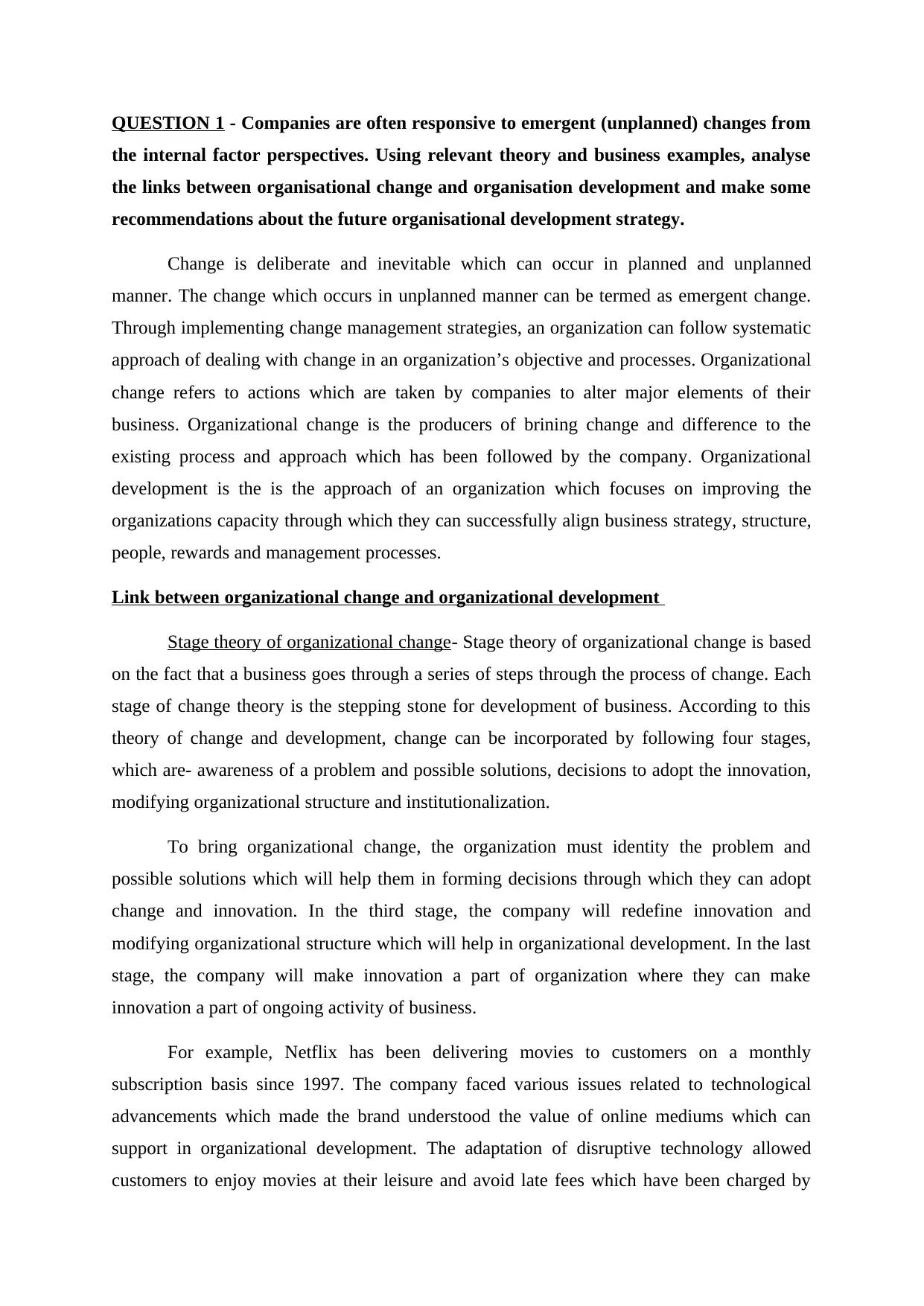
QUESTION 1 - Companies are often responsive to emergent (unplanned) changes from
the internal factor perspectives. Using relevant theory and business examples, analyse
the links between organisational change and organisation development and make some
recommendations about the future organisational development strategy.
Change is deliberate and inevitable which can occur in planned and unplanned
manner. The change which occurs in unplanned manner can be termed as emergent change.
Through implementing change management strategies, an organization can follow systematic
approach of dealing with change in an organization’s objective and processes. Organizational
change refers to actions which are taken by companies to alter major elements of their
business. Organizational change is the producers of brining change and difference to the
existing process and approach which has been followed by the company. Organizational
development is the is the approach of an organization which focuses on improving the
organizations capacity through which they can successfully align business strategy, structure,
people, rewards and management processes.
Link between organizational change and organizational development
Stage theory of organizational change- Stage theory of organizational change is based
on the fact that a business goes through a series of steps through the process of change. Each
stage of change theory is the stepping stone for development of business. According to this
theory of change and development, change can be incorporated by following four stages,
which are- awareness of a problem and possible solutions, decisions to adopt the innovation,
modifying organizational structure and institutionalization.
To bring organizational change, the organization must identity the problem and
possible solutions which will help them in forming decisions through which they can adopt
change and innovation. In the third stage, the company will redefine innovation and
modifying organizational structure which will help in organizational development. In the last
stage, the company will make innovation a part of organization where they can make
innovation a part of ongoing activity of business.
For example, Netflix has been delivering movies to customers on a monthly
subscription basis since 1997. The company faced various issues related to technological
advancements which made the brand understood the value of online mediums which can
support in organizational development. The adaptation of disruptive technology allowed
customers to enjoy movies at their leisure and avoid late fees which have been charged by
the internal factor perspectives. Using relevant theory and business examples, analyse
the links between organisational change and organisation development and make some
recommendations about the future organisational development strategy.
Change is deliberate and inevitable which can occur in planned and unplanned
manner. The change which occurs in unplanned manner can be termed as emergent change.
Through implementing change management strategies, an organization can follow systematic
approach of dealing with change in an organization’s objective and processes. Organizational
change refers to actions which are taken by companies to alter major elements of their
business. Organizational change is the producers of brining change and difference to the
existing process and approach which has been followed by the company. Organizational
development is the is the approach of an organization which focuses on improving the
organizations capacity through which they can successfully align business strategy, structure,
people, rewards and management processes.
Link between organizational change and organizational development
Stage theory of organizational change- Stage theory of organizational change is based
on the fact that a business goes through a series of steps through the process of change. Each
stage of change theory is the stepping stone for development of business. According to this
theory of change and development, change can be incorporated by following four stages,
which are- awareness of a problem and possible solutions, decisions to adopt the innovation,
modifying organizational structure and institutionalization.
To bring organizational change, the organization must identity the problem and
possible solutions which will help them in forming decisions through which they can adopt
change and innovation. In the third stage, the company will redefine innovation and
modifying organizational structure which will help in organizational development. In the last
stage, the company will make innovation a part of organization where they can make
innovation a part of ongoing activity of business.
For example, Netflix has been delivering movies to customers on a monthly
subscription basis since 1997. The company faced various issues related to technological
advancements which made the brand understood the value of online mediums which can
support in organizational development. The adaptation of disruptive technology allowed
customers to enjoy movies at their leisure and avoid late fees which have been charged by
Paraphrase This Document
Need a fresh take? Get an instant paraphrase of this document with our AI Paraphraser
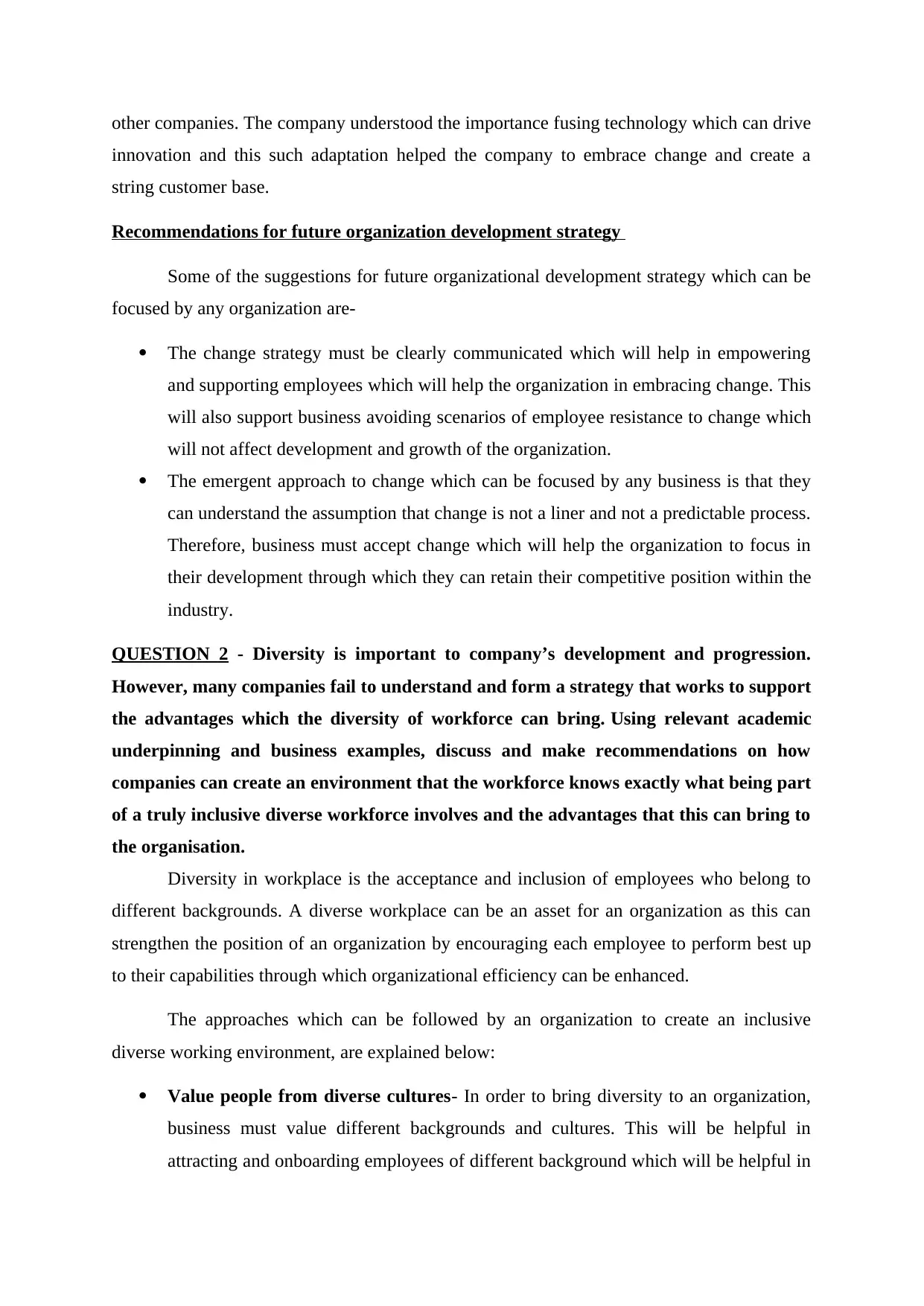
other companies. The company understood the importance fusing technology which can drive
innovation and this such adaptation helped the company to embrace change and create a
string customer base.
Recommendations for future organization development strategy
Some of the suggestions for future organizational development strategy which can be
focused by any organization are-
The change strategy must be clearly communicated which will help in empowering
and supporting employees which will help the organization in embracing change. This
will also support business avoiding scenarios of employee resistance to change which
will not affect development and growth of the organization.
The emergent approach to change which can be focused by any business is that they
can understand the assumption that change is not a liner and not a predictable process.
Therefore, business must accept change which will help the organization to focus in
their development through which they can retain their competitive position within the
industry.
QUESTION 2 - Diversity is important to company’s development and progression.
However, many companies fail to understand and form a strategy that works to support
the advantages which the diversity of workforce can bring. Using relevant academic
underpinning and business examples, discuss and make recommendations on how
companies can create an environment that the workforce knows exactly what being part
of a truly inclusive diverse workforce involves and the advantages that this can bring to
the organisation.
Diversity in workplace is the acceptance and inclusion of employees who belong to
different backgrounds. A diverse workplace can be an asset for an organization as this can
strengthen the position of an organization by encouraging each employee to perform best up
to their capabilities through which organizational efficiency can be enhanced.
The approaches which can be followed by an organization to create an inclusive
diverse working environment, are explained below:
Value people from diverse cultures- In order to bring diversity to an organization,
business must value different backgrounds and cultures. This will be helpful in
attracting and onboarding employees of different background which will be helpful in
innovation and this such adaptation helped the company to embrace change and create a
string customer base.
Recommendations for future organization development strategy
Some of the suggestions for future organizational development strategy which can be
focused by any organization are-
The change strategy must be clearly communicated which will help in empowering
and supporting employees which will help the organization in embracing change. This
will also support business avoiding scenarios of employee resistance to change which
will not affect development and growth of the organization.
The emergent approach to change which can be focused by any business is that they
can understand the assumption that change is not a liner and not a predictable process.
Therefore, business must accept change which will help the organization to focus in
their development through which they can retain their competitive position within the
industry.
QUESTION 2 - Diversity is important to company’s development and progression.
However, many companies fail to understand and form a strategy that works to support
the advantages which the diversity of workforce can bring. Using relevant academic
underpinning and business examples, discuss and make recommendations on how
companies can create an environment that the workforce knows exactly what being part
of a truly inclusive diverse workforce involves and the advantages that this can bring to
the organisation.
Diversity in workplace is the acceptance and inclusion of employees who belong to
different backgrounds. A diverse workplace can be an asset for an organization as this can
strengthen the position of an organization by encouraging each employee to perform best up
to their capabilities through which organizational efficiency can be enhanced.
The approaches which can be followed by an organization to create an inclusive
diverse working environment, are explained below:
Value people from diverse cultures- In order to bring diversity to an organization,
business must value different backgrounds and cultures. This will be helpful in
attracting and onboarding employees of different background which will be helpful in
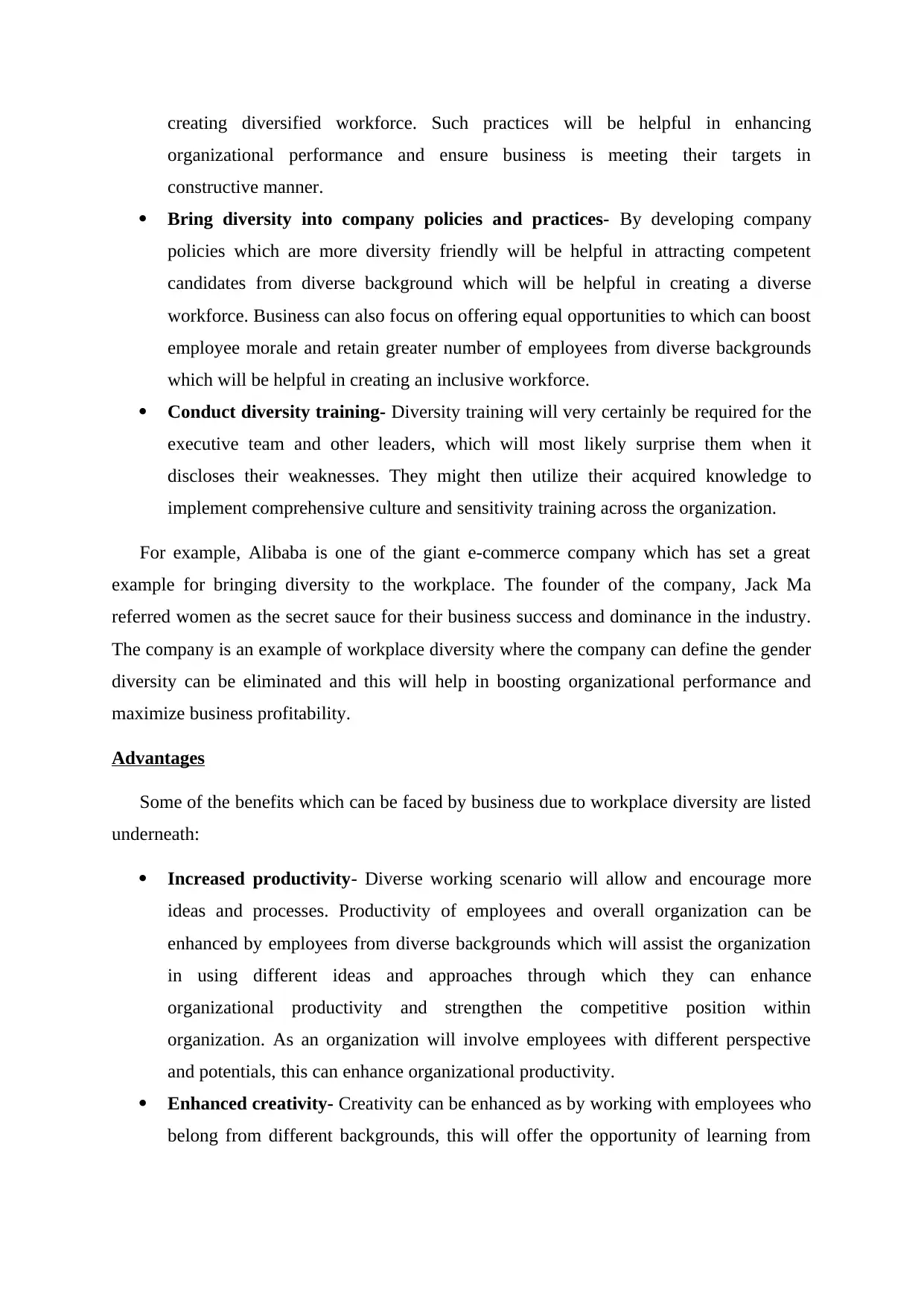
creating diversified workforce. Such practices will be helpful in enhancing
organizational performance and ensure business is meeting their targets in
constructive manner.
Bring diversity into company policies and practices- By developing company
policies which are more diversity friendly will be helpful in attracting competent
candidates from diverse background which will be helpful in creating a diverse
workforce. Business can also focus on offering equal opportunities to which can boost
employee morale and retain greater number of employees from diverse backgrounds
which will be helpful in creating an inclusive workforce.
Conduct diversity training- Diversity training will very certainly be required for the
executive team and other leaders, which will most likely surprise them when it
discloses their weaknesses. They might then utilize their acquired knowledge to
implement comprehensive culture and sensitivity training across the organization.
For example, Alibaba is one of the giant e-commerce company which has set a great
example for bringing diversity to the workplace. The founder of the company, Jack Ma
referred women as the secret sauce for their business success and dominance in the industry.
The company is an example of workplace diversity where the company can define the gender
diversity can be eliminated and this will help in boosting organizational performance and
maximize business profitability.
Advantages
Some of the benefits which can be faced by business due to workplace diversity are listed
underneath:
Increased productivity- Diverse working scenario will allow and encourage more
ideas and processes. Productivity of employees and overall organization can be
enhanced by employees from diverse backgrounds which will assist the organization
in using different ideas and approaches through which they can enhance
organizational productivity and strengthen the competitive position within
organization. As an organization will involve employees with different perspective
and potentials, this can enhance organizational productivity.
Enhanced creativity- Creativity can be enhanced as by working with employees who
belong from different backgrounds, this will offer the opportunity of learning from
organizational performance and ensure business is meeting their targets in
constructive manner.
Bring diversity into company policies and practices- By developing company
policies which are more diversity friendly will be helpful in attracting competent
candidates from diverse background which will be helpful in creating a diverse
workforce. Business can also focus on offering equal opportunities to which can boost
employee morale and retain greater number of employees from diverse backgrounds
which will be helpful in creating an inclusive workforce.
Conduct diversity training- Diversity training will very certainly be required for the
executive team and other leaders, which will most likely surprise them when it
discloses their weaknesses. They might then utilize their acquired knowledge to
implement comprehensive culture and sensitivity training across the organization.
For example, Alibaba is one of the giant e-commerce company which has set a great
example for bringing diversity to the workplace. The founder of the company, Jack Ma
referred women as the secret sauce for their business success and dominance in the industry.
The company is an example of workplace diversity where the company can define the gender
diversity can be eliminated and this will help in boosting organizational performance and
maximize business profitability.
Advantages
Some of the benefits which can be faced by business due to workplace diversity are listed
underneath:
Increased productivity- Diverse working scenario will allow and encourage more
ideas and processes. Productivity of employees and overall organization can be
enhanced by employees from diverse backgrounds which will assist the organization
in using different ideas and approaches through which they can enhance
organizational productivity and strengthen the competitive position within
organization. As an organization will involve employees with different perspective
and potentials, this can enhance organizational productivity.
Enhanced creativity- Creativity can be enhanced as by working with employees who
belong from different backgrounds, this will offer the opportunity of learning from
⊘ This is a preview!⊘
Do you want full access?
Subscribe today to unlock all pages.

Trusted by 1+ million students worldwide
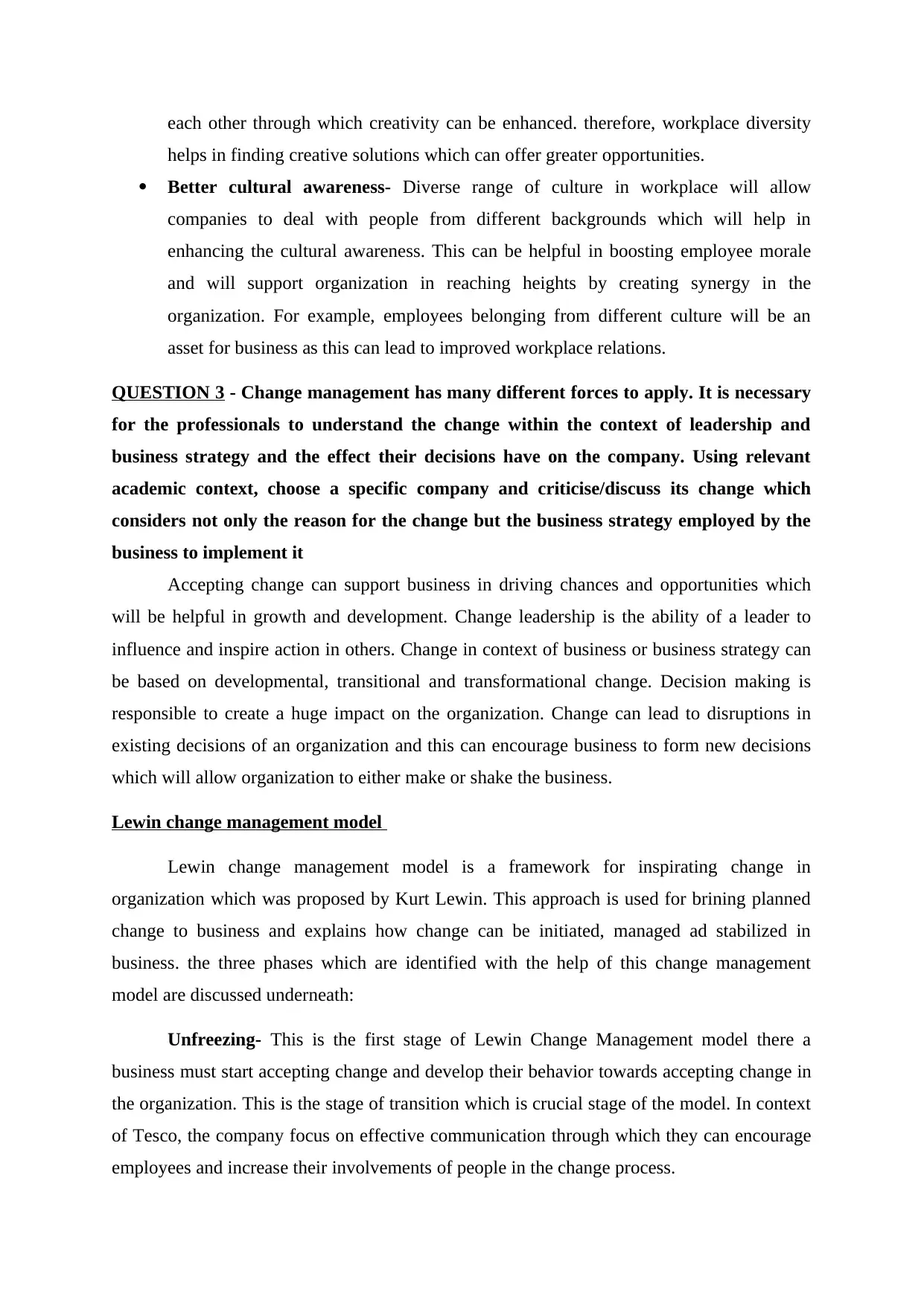
each other through which creativity can be enhanced. therefore, workplace diversity
helps in finding creative solutions which can offer greater opportunities.
Better cultural awareness- Diverse range of culture in workplace will allow
companies to deal with people from different backgrounds which will help in
enhancing the cultural awareness. This can be helpful in boosting employee morale
and will support organization in reaching heights by creating synergy in the
organization. For example, employees belonging from different culture will be an
asset for business as this can lead to improved workplace relations.
QUESTION 3 - Change management has many different forces to apply. It is necessary
for the professionals to understand the change within the context of leadership and
business strategy and the effect their decisions have on the company. Using relevant
academic context, choose a specific company and criticise/discuss its change which
considers not only the reason for the change but the business strategy employed by the
business to implement it
Accepting change can support business in driving chances and opportunities which
will be helpful in growth and development. Change leadership is the ability of a leader to
influence and inspire action in others. Change in context of business or business strategy can
be based on developmental, transitional and transformational change. Decision making is
responsible to create a huge impact on the organization. Change can lead to disruptions in
existing decisions of an organization and this can encourage business to form new decisions
which will allow organization to either make or shake the business.
Lewin change management model
Lewin change management model is a framework for inspirating change in
organization which was proposed by Kurt Lewin. This approach is used for brining planned
change to business and explains how change can be initiated, managed ad stabilized in
business. the three phases which are identified with the help of this change management
model are discussed underneath:
Unfreezing- This is the first stage of Lewin Change Management model there a
business must start accepting change and develop their behavior towards accepting change in
the organization. This is the stage of transition which is crucial stage of the model. In context
of Tesco, the company focus on effective communication through which they can encourage
employees and increase their involvements of people in the change process.
helps in finding creative solutions which can offer greater opportunities.
Better cultural awareness- Diverse range of culture in workplace will allow
companies to deal with people from different backgrounds which will help in
enhancing the cultural awareness. This can be helpful in boosting employee morale
and will support organization in reaching heights by creating synergy in the
organization. For example, employees belonging from different culture will be an
asset for business as this can lead to improved workplace relations.
QUESTION 3 - Change management has many different forces to apply. It is necessary
for the professionals to understand the change within the context of leadership and
business strategy and the effect their decisions have on the company. Using relevant
academic context, choose a specific company and criticise/discuss its change which
considers not only the reason for the change but the business strategy employed by the
business to implement it
Accepting change can support business in driving chances and opportunities which
will be helpful in growth and development. Change leadership is the ability of a leader to
influence and inspire action in others. Change in context of business or business strategy can
be based on developmental, transitional and transformational change. Decision making is
responsible to create a huge impact on the organization. Change can lead to disruptions in
existing decisions of an organization and this can encourage business to form new decisions
which will allow organization to either make or shake the business.
Lewin change management model
Lewin change management model is a framework for inspirating change in
organization which was proposed by Kurt Lewin. This approach is used for brining planned
change to business and explains how change can be initiated, managed ad stabilized in
business. the three phases which are identified with the help of this change management
model are discussed underneath:
Unfreezing- This is the first stage of Lewin Change Management model there a
business must start accepting change and develop their behavior towards accepting change in
the organization. This is the stage of transition which is crucial stage of the model. In context
of Tesco, the company focus on effective communication through which they can encourage
employees and increase their involvements of people in the change process.
Paraphrase This Document
Need a fresh take? Get an instant paraphrase of this document with our AI Paraphraser
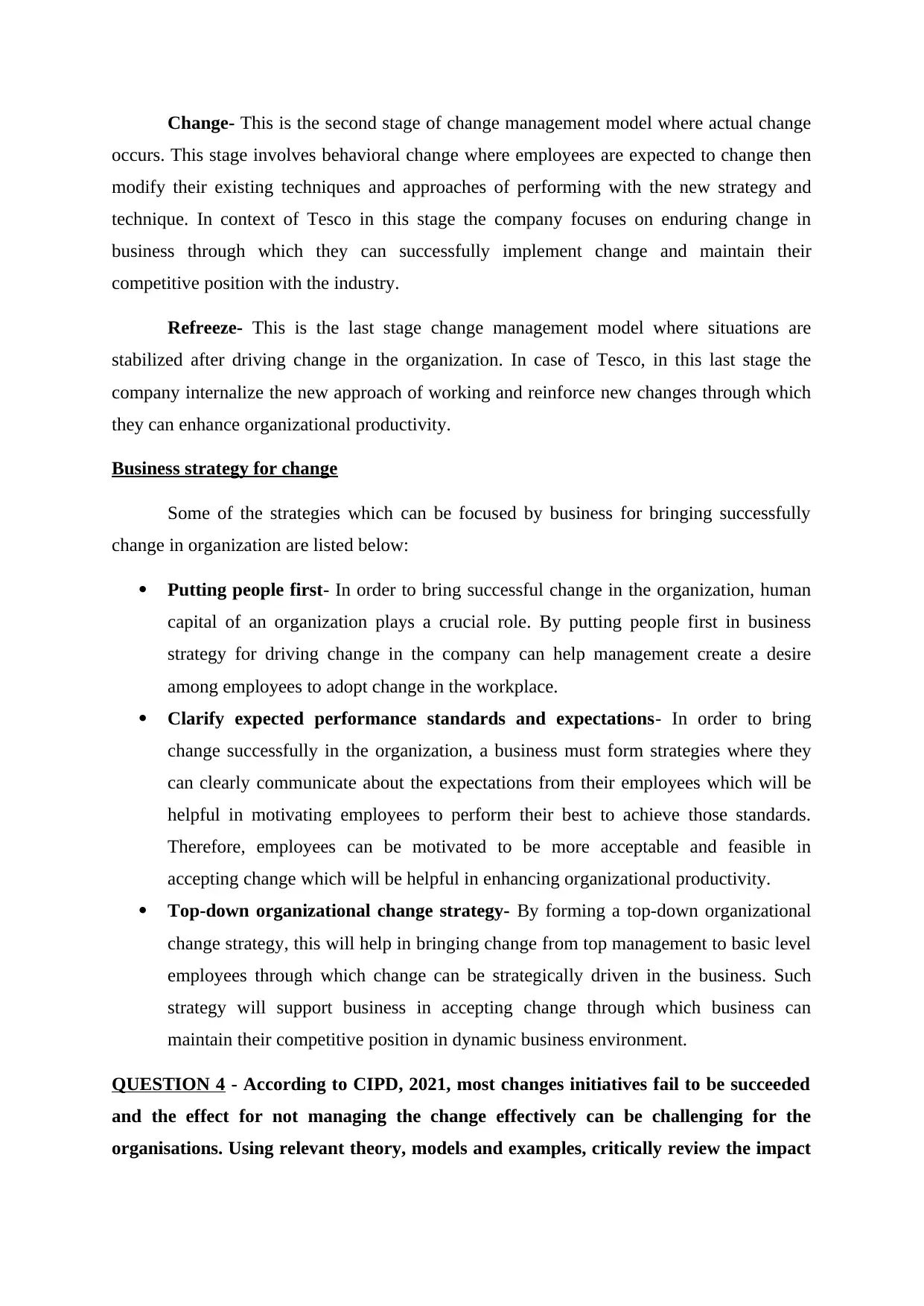
Change- This is the second stage of change management model where actual change
occurs. This stage involves behavioral change where employees are expected to change then
modify their existing techniques and approaches of performing with the new strategy and
technique. In context of Tesco in this stage the company focuses on enduring change in
business through which they can successfully implement change and maintain their
competitive position with the industry.
Refreeze- This is the last stage change management model where situations are
stabilized after driving change in the organization. In case of Tesco, in this last stage the
company internalize the new approach of working and reinforce new changes through which
they can enhance organizational productivity.
Business strategy for change
Some of the strategies which can be focused by business for bringing successfully
change in organization are listed below:
Putting people first- In order to bring successful change in the organization, human
capital of an organization plays a crucial role. By putting people first in business
strategy for driving change in the company can help management create a desire
among employees to adopt change in the workplace.
Clarify expected performance standards and expectations- In order to bring
change successfully in the organization, a business must form strategies where they
can clearly communicate about the expectations from their employees which will be
helpful in motivating employees to perform their best to achieve those standards.
Therefore, employees can be motivated to be more acceptable and feasible in
accepting change which will be helpful in enhancing organizational productivity.
Top-down organizational change strategy- By forming a top-down organizational
change strategy, this will help in bringing change from top management to basic level
employees through which change can be strategically driven in the business. Such
strategy will support business in accepting change through which business can
maintain their competitive position in dynamic business environment.
QUESTION 4 - According to CIPD, 2021, most changes initiatives fail to be succeeded
and the effect for not managing the change effectively can be challenging for the
organisations. Using relevant theory, models and examples, critically review the impact
occurs. This stage involves behavioral change where employees are expected to change then
modify their existing techniques and approaches of performing with the new strategy and
technique. In context of Tesco in this stage the company focuses on enduring change in
business through which they can successfully implement change and maintain their
competitive position with the industry.
Refreeze- This is the last stage change management model where situations are
stabilized after driving change in the organization. In case of Tesco, in this last stage the
company internalize the new approach of working and reinforce new changes through which
they can enhance organizational productivity.
Business strategy for change
Some of the strategies which can be focused by business for bringing successfully
change in organization are listed below:
Putting people first- In order to bring successful change in the organization, human
capital of an organization plays a crucial role. By putting people first in business
strategy for driving change in the company can help management create a desire
among employees to adopt change in the workplace.
Clarify expected performance standards and expectations- In order to bring
change successfully in the organization, a business must form strategies where they
can clearly communicate about the expectations from their employees which will be
helpful in motivating employees to perform their best to achieve those standards.
Therefore, employees can be motivated to be more acceptable and feasible in
accepting change which will be helpful in enhancing organizational productivity.
Top-down organizational change strategy- By forming a top-down organizational
change strategy, this will help in bringing change from top management to basic level
employees through which change can be strategically driven in the business. Such
strategy will support business in accepting change through which business can
maintain their competitive position in dynamic business environment.
QUESTION 4 - According to CIPD, 2021, most changes initiatives fail to be succeeded
and the effect for not managing the change effectively can be challenging for the
organisations. Using relevant theory, models and examples, critically review the impact
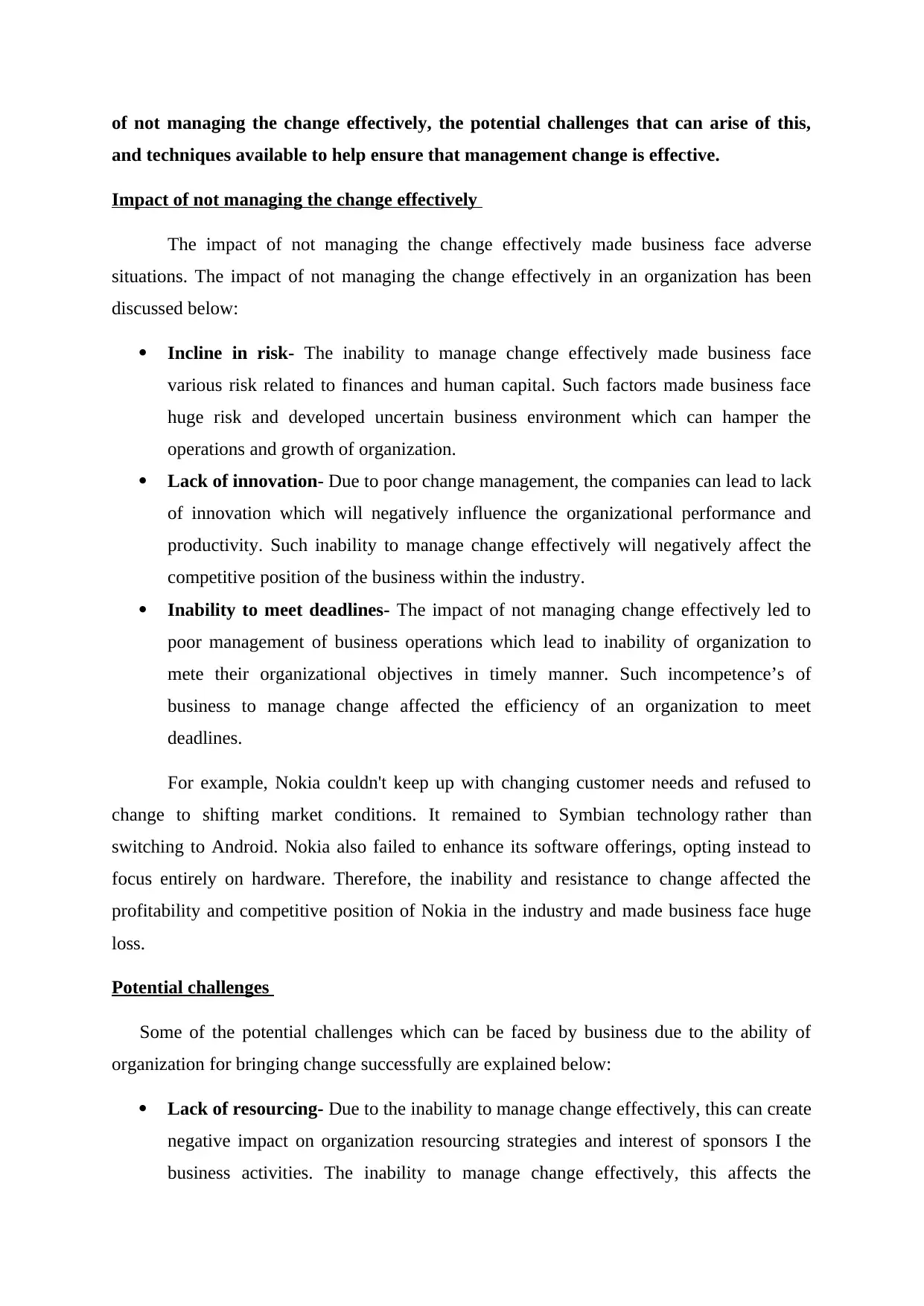
of not managing the change effectively, the potential challenges that can arise of this,
and techniques available to help ensure that management change is effective.
Impact of not managing the change effectively
The impact of not managing the change effectively made business face adverse
situations. The impact of not managing the change effectively in an organization has been
discussed below:
Incline in risk- The inability to manage change effectively made business face
various risk related to finances and human capital. Such factors made business face
huge risk and developed uncertain business environment which can hamper the
operations and growth of organization.
Lack of innovation- Due to poor change management, the companies can lead to lack
of innovation which will negatively influence the organizational performance and
productivity. Such inability to manage change effectively will negatively affect the
competitive position of the business within the industry.
Inability to meet deadlines- The impact of not managing change effectively led to
poor management of business operations which lead to inability of organization to
mete their organizational objectives in timely manner. Such incompetence’s of
business to manage change affected the efficiency of an organization to meet
deadlines.
For example, Nokia couldn't keep up with changing customer needs and refused to
change to shifting market conditions. It remained to Symbian technology rather than
switching to Android. Nokia also failed to enhance its software offerings, opting instead to
focus entirely on hardware. Therefore, the inability and resistance to change affected the
profitability and competitive position of Nokia in the industry and made business face huge
loss.
Potential challenges
Some of the potential challenges which can be faced by business due to the ability of
organization for bringing change successfully are explained below:
Lack of resourcing- Due to the inability to manage change effectively, this can create
negative impact on organization resourcing strategies and interest of sponsors I the
business activities. The inability to manage change effectively, this affects the
and techniques available to help ensure that management change is effective.
Impact of not managing the change effectively
The impact of not managing the change effectively made business face adverse
situations. The impact of not managing the change effectively in an organization has been
discussed below:
Incline in risk- The inability to manage change effectively made business face
various risk related to finances and human capital. Such factors made business face
huge risk and developed uncertain business environment which can hamper the
operations and growth of organization.
Lack of innovation- Due to poor change management, the companies can lead to lack
of innovation which will negatively influence the organizational performance and
productivity. Such inability to manage change effectively will negatively affect the
competitive position of the business within the industry.
Inability to meet deadlines- The impact of not managing change effectively led to
poor management of business operations which lead to inability of organization to
mete their organizational objectives in timely manner. Such incompetence’s of
business to manage change affected the efficiency of an organization to meet
deadlines.
For example, Nokia couldn't keep up with changing customer needs and refused to
change to shifting market conditions. It remained to Symbian technology rather than
switching to Android. Nokia also failed to enhance its software offerings, opting instead to
focus entirely on hardware. Therefore, the inability and resistance to change affected the
profitability and competitive position of Nokia in the industry and made business face huge
loss.
Potential challenges
Some of the potential challenges which can be faced by business due to the ability of
organization for bringing change successfully are explained below:
Lack of resourcing- Due to the inability to manage change effectively, this can create
negative impact on organization resourcing strategies and interest of sponsors I the
business activities. The inability to manage change effectively, this affects the
⊘ This is a preview!⊘
Do you want full access?
Subscribe today to unlock all pages.

Trusted by 1+ million students worldwide
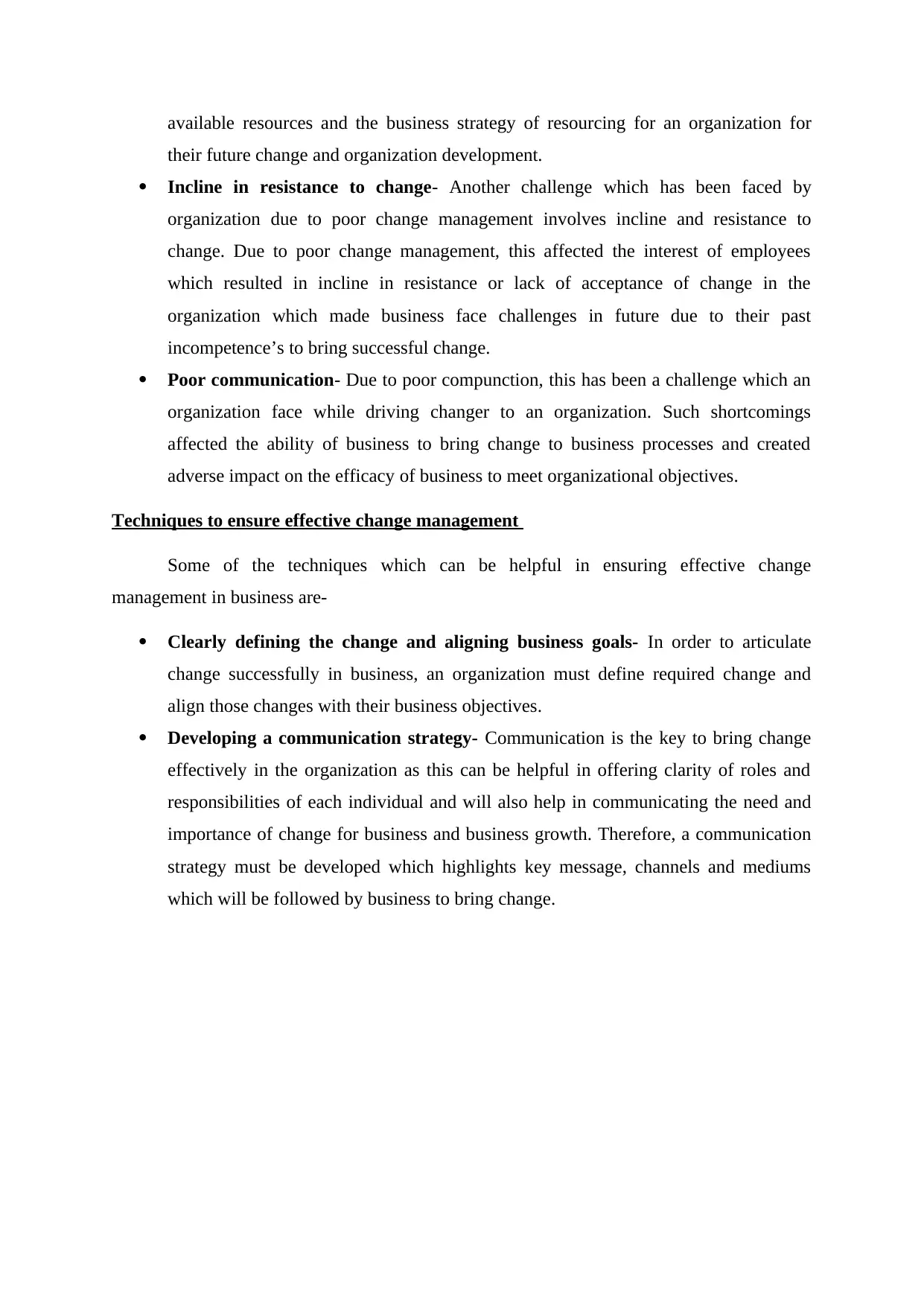
available resources and the business strategy of resourcing for an organization for
their future change and organization development.
Incline in resistance to change- Another challenge which has been faced by
organization due to poor change management involves incline and resistance to
change. Due to poor change management, this affected the interest of employees
which resulted in incline in resistance or lack of acceptance of change in the
organization which made business face challenges in future due to their past
incompetence’s to bring successful change.
Poor communication- Due to poor compunction, this has been a challenge which an
organization face while driving changer to an organization. Such shortcomings
affected the ability of business to bring change to business processes and created
adverse impact on the efficacy of business to meet organizational objectives.
Techniques to ensure effective change management
Some of the techniques which can be helpful in ensuring effective change
management in business are-
Clearly defining the change and aligning business goals- In order to articulate
change successfully in business, an organization must define required change and
align those changes with their business objectives.
Developing a communication strategy- Communication is the key to bring change
effectively in the organization as this can be helpful in offering clarity of roles and
responsibilities of each individual and will also help in communicating the need and
importance of change for business and business growth. Therefore, a communication
strategy must be developed which highlights key message, channels and mediums
which will be followed by business to bring change.
their future change and organization development.
Incline in resistance to change- Another challenge which has been faced by
organization due to poor change management involves incline and resistance to
change. Due to poor change management, this affected the interest of employees
which resulted in incline in resistance or lack of acceptance of change in the
organization which made business face challenges in future due to their past
incompetence’s to bring successful change.
Poor communication- Due to poor compunction, this has been a challenge which an
organization face while driving changer to an organization. Such shortcomings
affected the ability of business to bring change to business processes and created
adverse impact on the efficacy of business to meet organizational objectives.
Techniques to ensure effective change management
Some of the techniques which can be helpful in ensuring effective change
management in business are-
Clearly defining the change and aligning business goals- In order to articulate
change successfully in business, an organization must define required change and
align those changes with their business objectives.
Developing a communication strategy- Communication is the key to bring change
effectively in the organization as this can be helpful in offering clarity of roles and
responsibilities of each individual and will also help in communicating the need and
importance of change for business and business growth. Therefore, a communication
strategy must be developed which highlights key message, channels and mediums
which will be followed by business to bring change.
1 out of 7
Related Documents
Your All-in-One AI-Powered Toolkit for Academic Success.
+13062052269
info@desklib.com
Available 24*7 on WhatsApp / Email
![[object Object]](/_next/static/media/star-bottom.7253800d.svg)
Unlock your academic potential
Copyright © 2020–2026 A2Z Services. All Rights Reserved. Developed and managed by ZUCOL.




